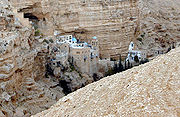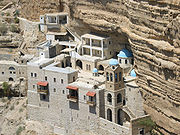
St. George's Monastery
Encyclopedia

Wadi Qelt
Wadi Qelt or Nahal Prat is a valley or stream running west to east across the Judean desert in the West Bank, originating near Jerusalem and terminating near Jericho, near the Dead Sea...
, in the eastern West Bank
West Bank
The West Bank ) of the Jordan River is the landlocked geographical eastern part of the Palestinian territories located in Western Asia. To the west, north, and south, the West Bank shares borders with the state of Israel. To the east, across the Jordan River, lies the Hashemite Kingdom of Jordan...
, . The sixth-century cliff-hanging complex, with its ancient chapel and gardens, is active and inhabited by Greek Orthodox monks. It is reached by a pedestrian bridge across the Wadi Qelt, which many imagine to be Psalm 23's Valley of the Shadow. The valley parallels the old Roman road to Jericho, the backdrop for the parable of the Good Samaritan (Luke 10:29-37). The monastery is open to pilgrims and visitors.
History

This Greek Orthodox monastery was built in the late 5th century A.D. by John of Thebes. He became a hermit and moved from Egypt to Syria Palaestina
Syria Palaestina
Syria Palæstina was a Roman province between 135CE and 390CE. It had been established by the merge of Roman Syria and Roman Judaea, following the defeat of the Bar Kokhba Revolt in 135 CE. In 193 Syria-Coele was split to form a separate provincial locality...
in 480 CE. The monastery was named St. George after the most famous monk who lived at the site – Gorgias of Coziba. Destroyed in 614 CE by the Persian
Sassanid Empire
The Sassanid Empire , known to its inhabitants as Ērānshahr and Ērān in Middle Persian and resulting in the New Persian terms Iranshahr and Iran , was the last pre-Islamic Persian Empire, ruled by the Sasanian Dynasty from 224 to 651...
s, the monastery was more or less abandoned after the Persians swept through the valley and massacred the fourteen monks who dwelt there. The Crusader
Crusades
The Crusades were a series of religious wars, blessed by the Pope and the Catholic Church with the main goal of restoring Christian access to the holy places in and near Jerusalem...
s made some attempts at restoration in 1179. However, it fell into disuse after their expulsion. In 1878, a Greek
Greeks
The Greeks, also known as the Hellenes , are a nation and ethnic group native to Greece, Cyprus and neighboring regions. They also form a significant diaspora, with Greek communities established around the world....
monk, Kalinikos, settled here and restored the monastery, finishing it in 1901. The traditions attached to the monastery include a visit by Elijah en route to the Sinai Peninsula
Sinai Peninsula
The Sinai Peninsula or Sinai is a triangular peninsula in Egypt about in area. It is situated between the Mediterranean Sea to the north, and the Red Sea to the south, and is the only part of Egyptian territory located in Asia as opposed to Africa, effectively serving as a land bridge between two...
, and St. Joachim
Joachim
Saint Joachim was the husband of Saint Anne and the father of Mary, the mother of Jesus in the Roman Catholic, Orthodox, and Anglican traditions. The story of Joachim and Anne appears first in the apocryphal Gospel of James...
, whose wife Anne was infertile, weeping here when an angel announced to him the news of Mary
Mary (mother of Jesus)
Mary , commonly referred to as "Saint Mary", "Mother Mary", the "Virgin Mary", the "Blessed Virgin Mary", or "Mary, Mother of God", was a Jewish woman of Nazareth in Galilee...
's conception. The bones and skulls of the martyred monks killed by the Persians in 614 CE can still be seen today in the monastery chapel.
Today
The monastery is located 20 km/12.5 mi from Jerusalem on the road to JerichoJericho
Jericho ; is a city located near the Jordan River in the West Bank of the Palestinian territories. It is the capital of the Jericho Governorate and has a population of more than 20,000. Situated well below sea level on an east-west route north of the Dead Sea, Jericho is the lowest permanently...
. There is a sign posted to the monastery, which goes off on the left from the rather higher north side which there is the first view of the gorge of the Wadi Qelt. From the parking lot there is a path only suitable for all-terrain vehicles which runs northeast (about 1.25 hours on foot) to a hill with a cross, from which there is a view of the Greek Orthodox monastery of St. George and far to the left, a rivulet flowing down the hillside from a spring, from which water is channeled to the monastery. The stony track continues (another half-hour's walk), to the entrance to the monastery, which clings precariously to the sheer north face of the gorge.

